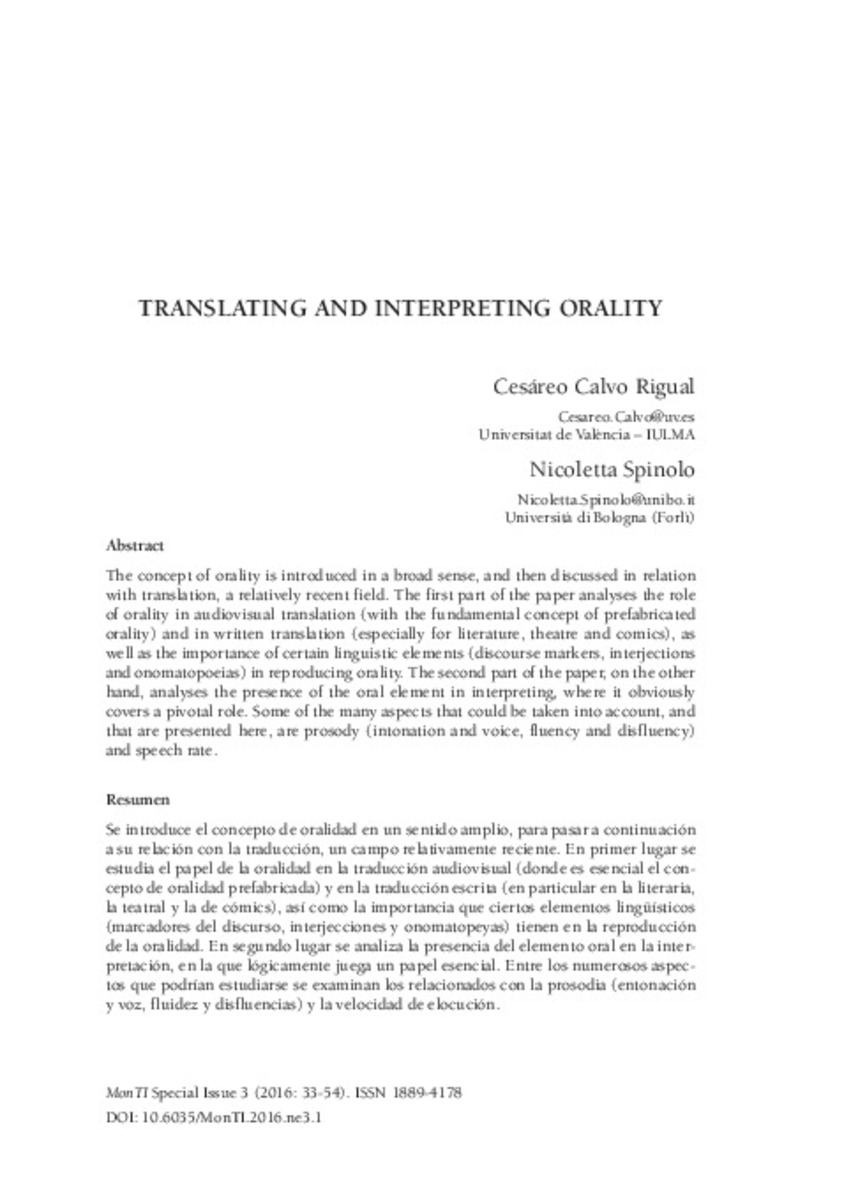Mostrar el registro sencillo del ítem
Translating and interpreting orality
| dc.contributor.author | Calvo Rigual, Cesáreo | |
| dc.contributor.author | Spinolo, Nicoletta | |
| dc.date.accessioned | 2018-02-19T10:08:50Z | |
| dc.date.available | 2018-02-19T10:08:50Z | |
| dc.date.issued | 2016 | |
| dc.identifier.citation | CALVO RIGUAL, Cesáreo; SPINOLO, Nicoletta. Translating and interpreting orality. MonTI: Monografías de traducción e interpretación, 2016, núm. esp. 3, p. 33-54. | ca_CA |
| dc.identifier.issn | 1889-4178 | |
| dc.identifier.issn | 1989-9335 (electrònic) | |
| dc.identifier.uri | http://hdl.handle.net/10234/172918 | |
| dc.description.abstract | Se introduce el concepto de oralidad en un sentido amplio, para pasar a continuación a su relación con la traducción, un campo relativamente reciente. En primer lugar se estudia el papel de la oralidad en la traducción audiovisual (donde es esencial el concepto de oralidad prefabricada) y en la traducción escrita (en particular en la literaria, la teatral y la de cómics), así como la importancia que ciertos elementos lingüísticos (marcadores del discurso, interjecciones y onomatopeyas) tienen en la reproducción de la oralidad. En segundo lugar se analiza la presencia del elemento oral en la interpretación, en la que lógicamente juega un papel esencial. Entre los numerosos aspectos que podrían estudiarse se examinan los relacionados con la prosodia (entonación y voz, fluidez y disfluencias) y la velocidad de elocución. | ca_CA |
| dc.description.abstract | The concept of orality is introduced in a broad sense, and then discussed in relation with translation, a relatively recent field. The first part of the paper analyses the role of orality in audiovisual translation (with the fundamental concept of prefabricated orality) and in written translation (especially for literature, theatre and comics), as well as the importance of certain linguistic elements (discourse markers, interjections and onomatopoeias) in reproducing orality. The second part of the paper, on the other hand, analyses the presence of the oral element in interpreting, where it obviously covers a pivotal role. Some of the many aspects that could be taken into account, and that are presented here, are prosody (intonation and voice, fluency and disfluency) and speech rate. | ca_CA |
| dc.format.extent | 22 p. | ca_CA |
| dc.format.mimetype | application/pdf | ca_CA |
| dc.language.iso | eng | ca_CA |
| dc.publisher | Universitat Jaume I | ca_CA |
| dc.publisher | Universitat de València | ca_CA |
| dc.publisher | Universitat d' Alacant | ca_CA |
| dc.relation.isPartOf | MonTI, 2016, núm. esp. 3 | ca_CA |
| dc.rights | © d’aquesta edició: Universitat d’Alacant, Universitat Jaume I, Universitat de València | ca_CA |
| dc.rights.uri | http://creativecommons.org/licenses/by/4.0/ | * |
| dc.subject | orality | ca_CA |
| dc.subject | translation | ca_CA |
| dc.subject | interpreting | ca_CA |
| dc.subject | oralidad | ca_CA |
| dc.subject | traducción | ca_CA |
| dc.subject | interpretación | ca_CA |
| dc.title | Translating and interpreting orality | ca_CA |
| dc.type | info:eu-repo/semantics/article | ca_CA |
| dc.identifier.doi | https://doi.org/10.6035/MonTI.2016.ne3.1 | |
| dc.rights.accessRights | info:eu-repo/semantics/openAccess | ca_CA |
| dc.relation.publisherVersion | http://www.e-revistes.uji.es/index.php/monti/article/view/2844 | ca_CA |
Ficheros en el ítem
Este ítem aparece en la(s) siguiente(s) colección(ones)
-
MonTi_ 2016 _núm.esp_3 [16]
Número especial 3








